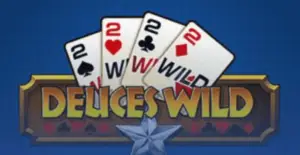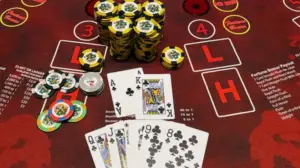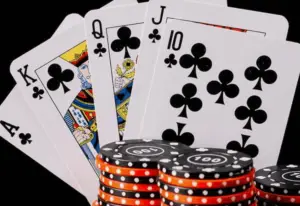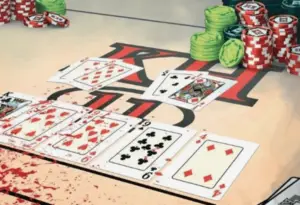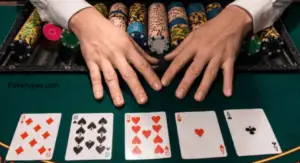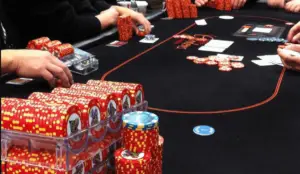Casino Holdem, created by Stephen Au-Yeung in 2000, represents a fascinating evolution in casino gaming. What started as a simple training tool to teach Texas Hold’em transformed into a globally recognized casino favorite.
Unlike traditional poker where players compete against each other, this variant pits players directly against the house dealer, making it a true banking game.
The game’s structure maintains the familiar elements of poker – using a standard 52-card deck and forming the best five-card hand – while introducing unique elements like the Ante bet and AA Bonus side bets.
Since its debut in Egypt, Russia, and South Africa, the game has gained significant traction in both brick-and-mortar and online casinos.
With potential payouts reaching 100 to 1 for a Royal Flush and a reasonable house edge of approximately 2.16%, Casino Hold’em offers an exciting blend of strategy and chance that appeals to both novice players and seasoned poker enthusiasts.
The Basics of Casino Hold’em
Casino Hold’em employs a classic 52-card deck with traditional poker rankings, setting the foundation for this exciting casino game.
The table layout features distinct betting areas, including spots for the mandatory Ante bet, optional AA Bonus, and Call bet positions.
Game Setup
The dealer position remains fixed at the center of the semi-circular table, facing up to seven players.
Each player position includes three clearly marked betting circles: one for the Ante (mandatory initial bet), one for the Call bet (twice the ante), and one for the optional AA Bonus side bet.
The community card area sits in the center, where five cards will eventually be displayed.
Betting Structure
Players begin by placing their Ante bet, which typically ranges from $5 to $100 depending on the casino. The optional AA Bonus side bet offers potential payouts up to 100 to 1 for a Royal Flush.
This exciting side bet pays when players make hands ranging from a pair of aces to a royal flush using their hole cards and the first three community cards.
Card Distribution
The dealing sequence follows a strict protocol:
Two face-down hole cards to each player
Two face-down cards to the dealer
Three face-up community cards (the flop)
Two more community cards (turn and river) if players call
The house edge averages 2.16% with optimal play, making it one of the more favorable table games in most casinos. Each hand takes approximately two minutes to complete, allowing for engaging yet efficient gameplay.
Rules and Regulations of Casino Hold’em
Dealer Requirements
The dealer must qualify with a pair of fours or better for the hand to proceed normally. When the dealer fails to qualify, the Ante bet pays according to the paytable, while the Call bet pushes.
The dealer follows a strict hand ranking system identical to traditional poker, from high card to Royal Flush.
Hand Rankings and Payouts
Standard Payouts:
- Royal Flush: 100 to 1
- Straight Flush: 20 to 1
- Four of a Kind: 10 to 1
- Full House: 3 to 1
- Flush: 2 to 1
- Straight or lower: 1 to 1
Player Guidelines
Players must follow specific betting limitations:
- Minimum Ante bet: Usually $5
- Maximum Ante bet: Typically $100
- Call bet: Must be exactly twice the Ante
Hand Formation Rules:
- Players must use exactly five cards
- Can combine any mix of hole cards and community cards
- Must make the best possible hand
Valid Combinations:
- Players can use:
- Both hole cards + three community cards
- One hole card + four community cards
- All five community cards
How to Play Casino Hold’em?
Opening Phase
The gameplay begins with the distribution of hole cards– two face-down cards dealt to each player and the dealer.
Using a standard 52-card deck, the action starts with players placing their Ante bets. The first three community cards, known as the flop, are then dealt face-up in the center of the table.
Decision Making
After seeing their hole cards and the flop, players face a crucial choice: Call or Fold. The Call bet must be twice the size of the original Ante, making this decision particularly significant.
For example, with a $5 Ante, the Call bet would be $10. Players who fold forfeit their Ante bet but retain any active side bets.
Strategic Considerations:
Pair or better: Always call
Ace or King: Generally call
Queen or Jack: Call unless community cards show flush potential
Drawing hands: Call with strong draws
Showdown Process
If players make the Call bet, the dealer reveals the final two community cards – the turn and river. These complete the five-card board.
The dealer then exposes their hole cards, and all hands are compared using the best five cards from the seven available (two hole cards plus five community cards).
Winning Conditions:
Dealer qualification: Must have a pair of fours or better
Hand rankings: Standard poker hierarchy applies
Payouts: Range from 1:1 to 100:1 for Royal Flush
Resolution Process
When the dealer qualifies:
- Winning players receive payments according to the Ante paytable
- Call bets to pay even money
- Tied hands result in a push
If the dealer fails to qualify:
- Ante bets pay according to paytable
- Call bets push
- Side bets resolve independently
Strategies for Casino Hold’em
1. Optimal Play
The key to success in Casino Hold’em lies is understanding optimal strategy, which yields an impressive 99.18% RTP when executed properly. Without a proper strategy, this can drop dramatically to 93% or lower.
Core Hand Selection Guidelines:
Pairs or Better: Always call with any pair
High Cards: Call with Ace or King holdings
Medium Holdings: Call Queen or Jack unless facing flush draws
Drawing Hands: Call with one-card draws to straights or flushes
2. Position and Betting Patterns
Unlike traditional poker, position plays a different role since you’re only competing against the dealer. The optimal strategy involves Betting Decisions:
Call approximately 82% of hands
Fold the worst 18% of holdings
The call bet must be exactly double the Ante
3. Mathematical Edge
The game carries a house edge of approximately 2.16%when played optimally. This makes it one of the more favorable casino games, particularly when following proper strategy. Probability Breakdown:
Royal Flush: 0.000026 probability (102:1 payout)
Straight Flush: 0.000216 probability (22:1 payout)
Four of a Kind: 0.001489 probability (12:1 payout)
Risk Management
Smart bankroll management is crucial for long-term success:
Bankroll Considerations:
- Set strict session limits
- Maintain a minimum of 20 units for proper variance handling
- Avoid chasing losses with increased bets
Expected Value Calculations:
The game’s mathematical structure favors certain decisions:
- Paired Boards: Higher expected value when calling
- Connected Cards: Better value with straight possibilities
- Suited Holdings: Increased equity with flush potential
Additional Features in Casino Hold’em
Side Bet Options
The AA Bonus and Progressive Jackpot add exciting layers to Casino Hold’em. The AA Bonuspays are based on your first five cards (two hole cards plus three flop cards), offering substantial rewards: AA Bonus Payouts:
- Royal Flush: 100 to 1
- Straight Flush: 50 to 1
- Four of a Kind: 40 to 1
- Full House: 30 to 1
- Flush: 20 to 1
- Pair of Aces to Straight: 7 to 1
Progressive Jackpot Structure
The Progressive Jackpot features four different paytables with varying meter contributions:
- Royal/Straight Flush: 8-9% meter contribution
- Four of a Kind: 9.5-20% contribution
- Full House: 8% contribution
- Base payouts for lower hands
House Edge Analysis
The game’s mathematical structure reveals favorable odds compared to many casino games: Statistical Breakdown:
- Main game house edge: 2.16%
- AA Bonus edge: 6.26-6.40%
- Progressive Jackpot return: 65.4-80.9%
Variance Factors:
- Optimal play raises 82% of hands
- Dealer qualification rate affects volatility
- Side bet variance is higher than the main game
When compared to other casino games, Casino Hold’em offers better odds than most table games, sitting between Blackjack(0.5%) and Three Card Poker(3.37%) in terms of house advantage.
Advanced Concepts to Become a Pro in Casino Hold’em
Professional success in Casino Hold’em requires mastering several advanced concepts. For bankroll management, experts recommend maintaining at least 20 units of your standard bet size and never risking more than 5% of your total bankroll on a single hand.
Pattern recognition skills develop through observing the dealer qualification frequency and tracking community card distributions.
Optimal decision-making follows a strict framework where players should call approximately 82% of hands and fold the remaining 18%. Common betting errors include chasing losses with increased bets and mismanaging the Call bet sizing, which must be exactly double the Ante.
Several strategic misconceptions plague newcomers, particularly regarding side bets. While the AA Bonus and Progressive Jackpot options seem attractive, they carry a significantly higher house edge than the base game.
The most serious risk assessment failure involves mishandling drawing hands – players should only call with one-card draws to straights or flushes and avoid runner-runner situations.
To maximize success, focus on maintaining strict betting discipline, using strategy calculators for complex decisions, and avoiding emotional play. Remember that Casino Hold’em rewards patient, methodical play over aggressive betting patterns.
Conclusion
Casino Hold’em continues to thrive with a favorable house edge of 2.16% and growing popularity in both land-based and online casinos.
The game’s blend of skill and chance, combined with side bet opportunities like the AA Bonus and Progressive Jackpot, offers exciting prospects for players.
Looking ahead, technological advancements are shaping the future with live dealer versions and mobile gaming platforms making the game more accessible.
The integration of AI-powered opponents and virtual reality features suggests a promising evolution while maintaining the game’s core appeal of competing against the house rather than other players.
With an optimal RTP of 99.18% when played strategically, Casino Hold’em remains a viable choice for both casual players and serious gamblers.

























